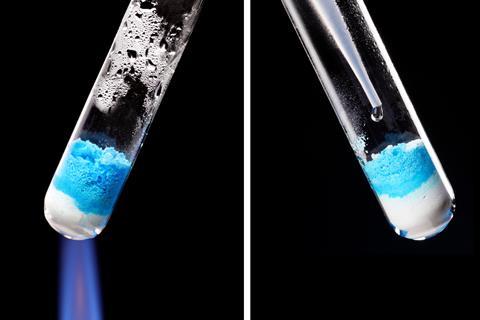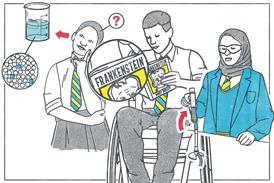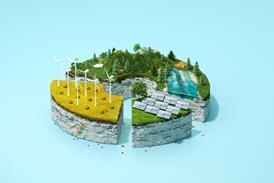Use these ideas in your classroom to secure your students’ understanding

We use the term ‘energy’ regularly in everyday life to describe how active someone feels or to refer to resources, such as electricity or oil. The scientific concept of energy is, however, much more precise. It was originally developed during the industrial revolution as the inventors of machines needed a way to calculate how much work could be done; for example, by a steam engine burning a certain amount of fuel.
As science teachers, we have to guide our students to see beyond the everyday meaning and help them to understand the principle and practice of calculating the energy transferred in different situations. Students begin to study energy at age 11, but many students start post-16 chemistry courses with a mixture of ideas about energy, which if not corrected can hamper progress.
What students need to know
- Energy transfers associated with chemical reactions involve heating or cooling the surroundings as a result of bonds making and breaking within the system.
- The enthalpy change refers to the change in the potential energy of the reaction system, which can be calculated by measuring the energy transferred as heat between system and surroundings (if measured at constant pressure).
- For an exothermic reaction, the enthalpy change is negative, whereas for an endothermic reaction, the enthalpy change is positive.
- The overall enthalpy change of a reaction is the same (for a given temperature and pressure), regardless of the route taken between reactants and products (Hess’s law).
Threshold concept
The overall enthalpy change of a chemical reaction allows us to quantify the relative contributions of the different bond breaking and making processes that occur. The relative strengths of the different bonds involved can be compared to provide a way of breaking down and analysing the different components that make up the chemical reaction. Even so, according to examiners’ reports, students often incorrectly define enthalpy changes and confuse signs and units in calculations.
Common misconceptions
Students are often unclear about the difference between enthalpy change, heat and thermal energy. Enthalpy change is best understood as the potential of a chemical reaction to transfer energy to or from the surroundings by heating or cooling it. Heat refers to the process of transferring the energy, whereas thermal energy refers to the energy due to random molecular motion that is responsible for the temperature of a system.
Despite having often been introduced to bond energy calculations in pre-16 courses, many students will still have a picture of energy ‘coming out’ of a bond when it breaks. This is not helped by terms like high energy bond, which is often used in biology to describe the bond in ATP that breaks in the exothermic reaction to form ADP and phosphate. For more information about energy, see chapter 11 of Vanessa Kind’s Beyond Appearances and Derek Denby’s Chemical energetics: words matter article.
Despite having often been introduced to bond energy calculations in pre-16 courses, many students will still have a picture of energy ‘coming out’ of a bond when it breaks. This is not helped by terms like high energy bond, which is often used in biology to describe the bond in ATP that breaks in the exothermic reaction to form ADP and phosphate. For more information about energy, see chapter 11 of Vanessa Kind’s book Beyond Appearances (rsc.li/3OORGjH) and Derek Denby’s ‘Chemical energetics: words matter article’ (rsc.li/3OPnG7C).
Ideas for your classroom
To help post-16 students better understand the concept of energy, find out what they already think. It can be revealing to ask ‘What is energy?’ and gather student responses as a think, pair, share activity.
Ensure you are up to date with recommended language and approaches to discussing energy. The energy guidance notes for teaching 14–16 from the Institute of Physics is very helpful. Talking to colleagues who teach physics and biology will ensure the language used is consistent across all science disciplines.
Ensure you are up to date with recommended language and approaches to discussing energy. The energy guidance notes for teaching 14–16 (bit.ly/3nMN2ak) from the Institute of Physics is very helpful. Talking to colleagues who teach physics and biology will ensure the language used is consistent across all science disciplines.
To help students sort out their ideas about thermal energy, heat and enthalpy, consider teaching the Maxwell–Boltzmann distribution before looking at enthalpy changes. This simple interactive online simulation is a great way to investigate the difference between hotter and colder temperatures in terms of their molecular motion (ie thermal energy).
Energy calculations are powerful tools that enable us to answer the fundamental question of why chemical reactions take place
To help students sort out their ideas about thermal energy, heat and enthalpy, consider teaching the Maxwell–Boltzmann distribution before looking at enthalpy changes. You can use the simple interactive online simulation from Falstad (bit.ly/3nL7CHX) to investigate the difference between hotter and colder temperatures in terms of their molecular motion (ie thermal energy).
To reinforce understanding that molecular motion is created by bond making, see this convincing simulation from the Concord Consortium Molecular Workbench series. It shows the formation of water molecules from unbonded hydrogen and oxygen atoms. You can download a resource to use as a class demonstration or an individual activity.
To reinforce understanding that molecular motion is created by bond making, share the Concord Consortium Molecular Workbench simulation (bit.ly/3uwNygm) of the formation of water molecules from unbonded hydrogen and oxygen atoms with your students. You can download a resource to use as a class demonstration or an individual activity.
Once students have a secure understanding of the energy transfers involved with enthalpy changes, they will be well placed to go on to tackle Hess’s law calculations. It’s not unusual to teach these by rote without really considering why they are important. You might find the practical ideas in the How can enthalpy changes be measured? lesson plans useful for this. To see how an energy level diagram approach to Hess’s law might be effective, read the second part of Derek Denby’s Chemical energetics: words matter article. You can further develop this method by using graph paper to show the size of enthalpy changes to scale. This allows students to visualise the relative contributions of different energy transfers to the overall enthalpy change.
Once students have a secure understanding of the energy transfers involved with enthalpy changes, they will be well placed to go on to tackle Hess’s law calculations. It’s not unusual to teach these by rote without really considering why they are important. You might find the practical ideas in the ‘How can enthalpy changes be measured?’ lesson plans useful for this (rsc.li/3Rl4XSP). To see how an energy level diagram approach to Hess’s law might be effective, read the second part of Derek Denby’s ‘Chemical energetics: words matter’ article. You can further develop this method by using graph paper to show the size of enthalpy changes to scale. This allows students to visualise the relative contributions of different energy transfers to the overall enthalpy change.
Checking students’ understanding
Check your students’ understanding of energy transfers by asking them to write a description of how to carry out the calculation of an enthalpy change using the relevant bond energy data. Encourage them to explain the reason behind each step. Some students may have memorised how to do this type of calculation, in which case it will be clear from their use of terminology that their understanding is not yet secure.
Take-home point
Giving students a good understanding of why we are interested in calculating the energy changes associated with the different components of a chemical reaction will lay a firm foundation for further study of thermodynamics during their post-16 course. Topics they might meet include Born–Haber cycles and the relationship between enthalpy, entropy, free energy and feasibility of reactions. Therefore energy calculations are powerful tools that enable us to answer the fundamental question of why chemical reactions take place at all.
Martin Bluemel, a retired head of chemistry with more than 30 years of classroom experience









No comments yet